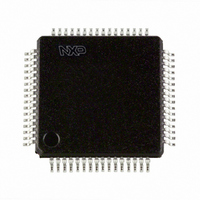P89LPC9402FBD,557 NXP Semiconductors, P89LPC9402FBD,557 Datasheet - Page 9

P89LPC9402FBD,557
Manufacturer Part Number
P89LPC9402FBD,557
Description
IC 80C51 MCU FLASH 8K 64-LQFP
Manufacturer
NXP Semiconductors
Series
LPC900r
Datasheet
1.P89LPC9402FBD557.pdf
(60 pages)
Specifications of P89LPC9402FBD,557
Program Memory Type
FLASH
Program Memory Size
8KB (8K x 8)
Package / Case
64-LQFP
Core Processor
8051
Core Size
8-Bit
Speed
18MHz
Connectivity
I²C, SPI, UART/USART
Peripherals
Brown-out Detect/Reset, LCD, LED, POR, PWM, WDT
Number Of I /o
23
Ram Size
256 x 8
Voltage - Supply (vcc/vdd)
2.4 V ~ 3.6 V
Oscillator Type
Internal
Operating Temperature
-40°C ~ 85°C
Processor Series
P89LPC
Core
80C51
Data Bus Width
8 bit
Data Ram Size
256 B
Interface Type
I2C, SPI, UART
Maximum Clock Frequency
18 MHz
Number Of Programmable I/os
20
Number Of Timers
2
Operating Supply Voltage
2.4 V to 3.6 V
Maximum Operating Temperature
+ 85 C
Mounting Style
SMD/SMT
3rd Party Development Tools
PK51, CA51, A51, ULINK2
Minimum Operating Temperature
- 40 C
Lead Free Status / RoHS Status
Lead free / RoHS Compliant
Eeprom Size
-
Data Converters
-
Lead Free Status / Rohs Status
Lead free / RoHS Compliant
Other names
935288631557
Available stocks
Company
Part Number
Manufacturer
Quantity
Price
Company:
Part Number:
P89LPC9402FBD,557
Manufacturer:
NXP Semiconductors
Quantity:
10 000
NXP Semiconductors
Table 3.
P89LPC9402_1
Product data sheet
Symbol
P1.5/RST
P1.6
P1.7
P2.0 to P2.3,
P2.5
P2.0
P2.1
P2.2/MOSI
P2.3/MISO
P2.5/SPICLK
P3.0 to P3.1
P3.0/XTAL2/
CLKOUT
P3.1/XTAL1
SDA_LCD
SCL_LCD
BP0 to BP3
Pin description
Pin
11
10
9
6
7
18
19
20
14
13
63
64
27 to 30
…continued
Type Description
I
I
I/O
I/O
I/O
I/O
I/O
I/O
I/O
I/O
I/O
I/O
I/O
I/O
I/O
O
O
I/O
I
I/O
I/O
O
P1.5 — Port 1 bit 5 (input only).
RST — External Reset input during power-on or if selected via UCFG1. When
functioning as a reset input, a LOW on this pin resets the microcontroller, causing I/O
ports and peripherals to take on their default states, and the processor begins
execution at address 0. Also used during a power-on sequence to force ISP mode.
P1.6 — Port 1 bit 6. High current source.
P1.7 — Port 1 bit 7. High current source.
Port 2: Port 2 is an 5-bit I/O port with a user-configurable output type. During reset
Port 2 latches are configured in the input only mode with the internal pull-up disabled.
The operation of Port 2 pins as inputs and outputs depends upon the port configuration
selected. Each port pin is configured independently. Refer to
configurations”
All pins have Schmitt trigger inputs.
Port 2 also provides various special functions as described below:
P2.0 — Port 2 bit 0.
P2.1 — Port 2 bit 1.
P2.2 — Port 2 bit 2.
MOSI — SPI master out slave in. When configured as master, this pin is output; when
configured as slave, this pin is input.
P2.3 — Port 2 bit 3.
MISO — When configured as master, this pin is input, when configured as slave, this
pin is output.
P2.5 — Port 2 bit 5.
SPICLK — SPI clock. When configured as master, this pin is output; when configured
as slave, this pin is input.
Port 3: Port 3 is a 2-bit I/O port with a user-configurable output type. During reset
Port 3 latches are configured in the input only mode with the internal pull-up disabled.
The operation of Port 3 pins as inputs and outputs depends upon the port configuration
selected. Each port pin is configured independently. Refer to
configurations”
All pins have Schmitt triggered inputs.
Port 3 also provides various special functions as described below:
P3.0 — Port 3 bit 0.
XTAL2 — Output from the oscillator amplifier (when a crystal oscillator option is
selected via the flash configuration.
CLKOUT — CPU clock divided by 2 when enabled via SFR bit (ENCLK - TRIM.6). It
can be used if the CPU clock is the internal RC oscillator, watchdog oscillator or
external clock input, except when XTAL1/XTAL2 are used to generate clock source for
the RTC/system timer.
P3.1 — Port 3 bit 1.
XTAL1 — Input to the oscillator circuit and internal clock generator circuits (when
selected via the flash configuration). It can be a port pin if internal RC oscillator or
watchdog oscillator is used as the CPU clock source, and if XTAL1/XTAL2 are not used
to generate the clock for the RTC/system timer.
SDA LCD — I
SCL LCD — I
BP0 to BP3: LCD backplane outputs.
2
2
Rev. 01 — 22 April 2009
C-bus clock signal for the LCD controller.
C-bus data signal for the LCD controller.
and
and
8-bit microcontroller with accelerated two-clock 80C51 core
Table 12 “Static electrical characteristics”
Table 12 “Static electrical characteristics”
P89LPC9402
Section 7.14.1 “Port
Section 7.14.1 “Port
for details.
for details.
© NXP B.V. 2009. All rights reserved.
9 of 60















